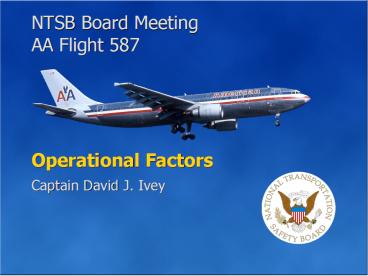Operational Factors - PowerPoint PPT Presentation
1 / 35
Title:
Operational Factors
Description:
American Airlines Advanced Aircraft Maneuvering Program (AAMP) ... American Airlines Flight 587. Belle Harbor, New York. November 12, 2001. NTSB Board Meeting ... – PowerPoint PPT presentation
Number of Views:84
Avg rating:3.0/5.0
Title: Operational Factors
1
Operational Factors
- Captain David J. Ivey
2
Training Issues
3
Training Issues
- American Airlines Advanced Aircraft Maneuvering
Program (AAMP)
4
Training Issues
- American Airlines Advanced Aircraft Maneuvering
Program (AAMP) - Lack of flight crew training about the A300-600
rudder system
5
Training Issues
- American Airlines Advanced Aircraft Maneuvering
Program (AAMP) - Lack of pilot training about the A300-600 rudder
system - Changes in rudder pedal sensitivity
- Changes in rudder pedal travel limits
- Airplane response to rudder inputs
- Design maneuver speed
6
American Airlines Advanced Aircraft Maneuvering
Program
- Ground School Training
- Simulator Flight Training
7
AAMP Ground School Training
8
AAMP Ground School Training
- Unusual attitudes and recovery strategies
9
AAMP Ground School Training
- Unusual attitudes and recovery strategies
- Aerodynamics and use of flight controls,
including rudder, during recovery
10
AAMP Ground School Training
- Did not fully explain airplane response to rudder
inputs
11
AAMP Ground School Training
- Did not fully explain airplane response to rudder
inputs - Did not explain rudder pedal characteristics at
higher airspeeds
12
AAMP Simulator Flight Training
- Insert picture of the single simulator
13
Excessive Bank Angle Exercise
14
Excessive Bank Angle Exercise
- Wake turbulence scenario
15
Excessive Bank Angle Exercise
- Wake turbulence scenario
- Roll 10 degrees in one direction
16
Excessive Bank Angle Exercise
- Wake turbulence scenario
- Roll 10 degrees in one direction
- Roll past 90 degrees in the opposite direction
17
Excessive Bank Angle Exercise
- Wake turbulence scenario
- Roll 10 degrees in one direction
- Roll past 90 degrees in the opposite direction
- Flight controls initially inhibited
18
Excessive Bank Angle Exercise
- Wake turbulence scenario
- Roll 10 degrees in one direction
- Roll past 90 degrees in the opposite direction
- Flight controls initially inhibited
- Pilots unaware that flight controls were
initially inhibited
19
Simulator Flight Training Deficiencies
20
Simulator Flight Training Deficiencies
- Unrealistic wake turbulence encounter
21
Simulator Flight Training Deficiencies
- Unrealistic wake turbulence encounter
- Flight control inhibition may have conditioned
use of rudder
22
Simulator Flight Training Deficiencies
- Unrealistic wake turbulence encounter
- Flight control inhibition may have conditioned
use of rudder - Potentially masked movement of rudder pedal stops
23
Simulator Flight Training Deficiencies
- Unrealistic wake turbulence encounter
- Flight control inhibition may have conditioned
use of rudder - Potentially masked movement of rudder pedal stops
- Pilots not informed of changing rudder pedal
sensitivity and travel limits
24
Simulator Flight Training Deficiencies
- Unrealistic wake turbulence encounter
- Flight control inhibition may have conditioned
use of rudder - Potentially masked movement of rudder pedal
stops - Pilots not informed of changing rudder pedal
sensitivity and travel limits - No feedback on G loading
25
Flight Crews Lack Experience in Rudder Use at
High Airspeeds
26
Flight Crews Lack Experience in Rudder Use at
High Airspeeds
- Pilots are experienced in using control column
and wheel at all airspeeds.
27
Flight Crews Lack Experience in Rudder Use at
High Airspeeds
- Pilots are experienced in using control column
and wheel at all airspeeds. - Pilots primarily use rudder controls at low
airspeeds.
28
Flight Crews Lack Experience in Rudder Use at
High Airspeeds
- Pilots are experienced in using control column
and wheel at all airspeeds. - Pilots primarily use rudder controls at low
airspeeds. - Pilots may not have experienced airplane response
resulting from rudder use at high airspeeds.
29
Flight Crews Lack Experience in Rudder Use at
High Airspeeds
- Pilots are experienced in using control column
and wheel at all airspeeds. - Pilots primarily use rudder controls at low
airspeeds. - Pilots have not experienced airplane response
resulting from rudder use at high airspeeds. - Lack of experience is typical of pilots
throughout the industry.
30
Additional Flight Crew Misconceptions
31
Additional Flight Crew Misconceptions
- Alternating rudder inputs were safe below design
maneuvering speed (VA).
32
Additional Flight Crew Misconceptions
- Alternating rudder inputs were safe below design
maneuvering speed (VA). - The rudder limiting system would protect the
structure from pilot inputs.
33
Additional Flight Crew Misconceptions
- Alternating rudder inputs were safe below design
maneuvering speed (VA). - The rudder limiting system would protect the
structure from pilot inputs. - The rudder pedal travel and rudder pedal forces
were thought to be unchanged.
34
Conclusion
- AAMP did not address rudder pedal forces at high
airspeeds. - Simulator training did not present realistic wake
turbulence scenarios. - Operating manuals did not provide useful
information.
35
National Transportation Safety Board
American Airlines Flight 587 Belle Harbor, New Yo
rk November 12, 2001 NTSB Board Meeting Octob
er 26, 2004































